#late dynastic period
Text
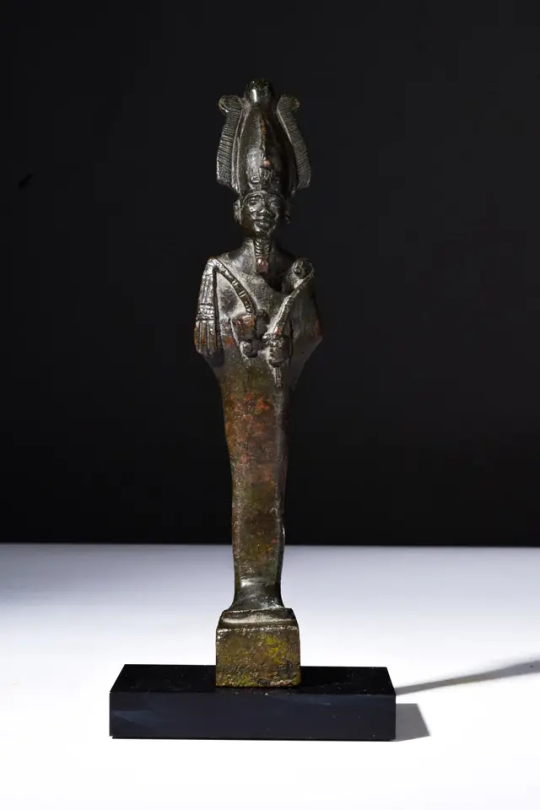
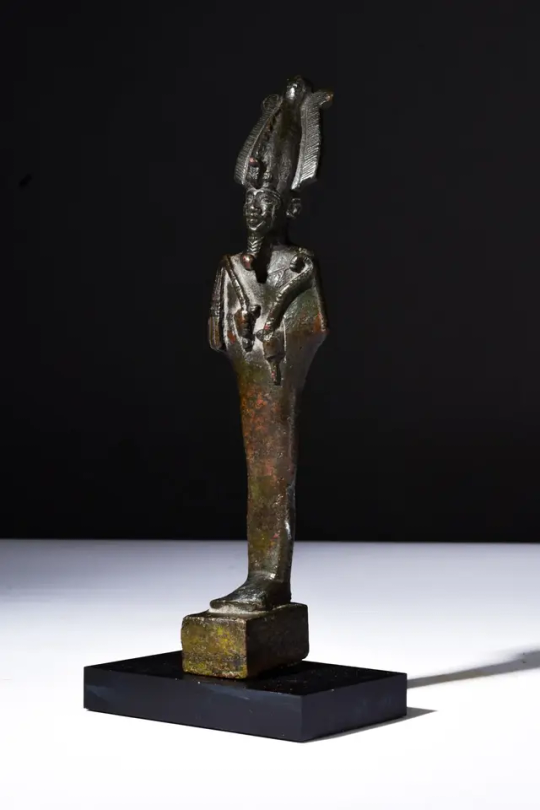
EGYPTIAN BRONZE STATUETTE OF OSIRIS
Late Dynastic Period, ca. 664-332 BC.
A bronze figure of Osiris in a mummiform position holding the crook and flail. He is depicted with a braided divine beard and wearing the atef crown with plumes of ostrich feathers which symbolises power and shows his role as king in the afterlife. Osiris was one of the most popular ancient Egyptian gods and was connected with male fertility. He was said to be the first Pharaoh of Egypt and was murdered by his brother Seth for his crown. Osiris was revived by Isis, his wife, and sister, to conceive Horus, the son who would avenge his death. After death, Osiris became ruler of the underworld and God of the dead, which is why he is shown with the crook and flail, the symbols of authority for Egyptian rulers.
#EGYPTIAN BRONZE STATUETTE OF OSIRIS#Late Dynastic Period#ca. 664-332 BC#bronze#bronze statue#bronze sculpture#ancient artifacts#archeology#archeolgst#history#history news#ancient history#ancient culture#ancient civilizations#ancient egypt#egyptian history#egyptian art
96 notes
·
View notes
Text

The Ancient Egyptian economy was based on the breadst standard!𓏏
😄
#history#ancient egypt#bread#beer#economy#ancient history#egyptology#currency#pfs#baking value#ancient#food#ancient egyptian history#barter#banking#old kingdom#middle kingdom#new kingdom#late dynastic period#food history#ancient practices#ancient egyptians#baking#brewing#economic history#nickys facts
13 notes
·
View notes
Photo

Egyptian Amethyst Amulet In The Form Of A Seated Cat,
Late Dynastic Period, 25th-31st Dynasty, 715-332 BC
Height: 2. 5 cm
The cat sits on its haunches on an integral base, its tail neatly curled to the right. Its front paws are held next to each other at the end of strong, broad legs. Erect pointed ears crown the finely detailed face. At the top of the shoulders a striated circular suspension loop. This is a particularly large and handsome example of the type of amulet that was made using, semi precious stones admired for their beauty and decorative qualities.
Courtesy: Christie’s
#art#design#jewellery#jewelry#egypt#amethyst#amulet#cat#late dynastic period#gemstone#semi-precious stones#christie's#style#history
110 notes
·
View notes
Text
in the Egyptian wing of the museum and my boyfriend is like "what are all the time periods of ancient Egypt" and I'm like predynastic, early dynastic, old kingdom which is when the pyramids were built, first intermediate, middle kingdom, second intermediate, new kingdom which includes amarna period and yugioh, third intermediate, and then all the late period stuff and macedonian and roman eras. and he's like run that by me one more time
57K notes
·
View notes
Text
Looted ancient sarcophagus returned to Egypt from US

An ancient wooden sarcophagus that was featured at the Houston Museum of Natural Sciences was returned to Egypt after U.S. authorities determined it was looted years ago, Egyptian officials said Monday.
The repatriation is part of Egyptian government efforts to stop the trafficking of its stolen antiquities. In 2021, authorities in Cairo succeeded in getting 5,300 stolen artifacts returned to Egypt from across the world.
Mostafa Waziri, the top official at the Supreme Council of Antiquities, said the sarcophagus dates back to the Late Dynastic Period of ancient Egypt, an era that spanned the last of the Pharaonic rulers from 664 B.C. until Alexander the Great's campaign in 332 B.C. Read more.
1K notes
·
View notes
Text
like seriously guys the ancient egyptians didn't worship cats for their entire civ's run, nor even most of it - that was a late period happenstance. maybe 300 years of that. actual fucking blip on the radar of 3000 years of dynastic history.
143 notes
·
View notes
Text
it's time for bed; m.k.
pairing: marc spector x reader, steven grant x reader, jake lockley x reader
summary: the boys help out when you have trouble falling asleep.
warnings: none, just fluff all the way through.
MOON KNIGHT MASTERLIST | ALL MASTERLISTS

steven
out of the three of them, steven’s the one who stays up the most. between late night inventory shifts at the museum and getting sucked into a new thousand-page tomb he picked up at a bookstore, he’s the one who tends to bid you goodnight with a sheepish smile, promising that he’ll join you in just a minute, love—I’m almost done.
of course he gets carried away—how couldn’t he? you can’t leave a book halfway through a chapter, after all. but the next chapter is only a dozen or so pages, he can get through that in a jiffy.
repeat that ad infinitum and then it’s late late, which makes him immediately embarrassed when you scuffle out of bed to where he’s seated on the couch.
“sorry, darling—lost track of time.” he slots a bookmark into his current page, giving you a warm smile as he stands. “I’ll come join you now—”
you shake your head, and steven frowns. “everything alright?”
“can’t sleep, s’all.” you mumble and he hums, pulling you down onto the couch with him. you lay your head in his lap, and he covers you with a throw blanket.
“you’re in for a treat tonight,” he says, voice soft as he picks up where he left off. “just started the part on conflicts during the first intermediate period of egypt.”
he starts reading again, out loud this time. steven keeps one hand in your hair, the other tracing over the words as he goes.
“Stable eras of Egyptian history are referred to as 'kingdoms' while eras of political strife or instability are known as 'intermediate periods.' this period has long been labeled a 'dark age'—oh, those are always fun, hm?” he raises his eyebrows and you can’t help but snort softly before he continues. “…When the central government of the old kingdom, which had been built on the model of the early dynastic period in Egypt…”
steven’s always had a nice voice but it’s gentler now, accent rolling over each syllable as he reads. his fingers lightly scratch your scalp and combined with the soothing sound of him speaking, you feel your eyelids grow heavy with each page he turns.
the first time you fell asleep while he read to you, it was on accident.
you just… couldn’t help it. there’s nothing more relaxing than listening to steven animate words on paper, injecting his comments here and there whenever he found something particularly interesting.
but even when you’d flushed red upon waking, steven wasn’t offended in the slightest.
why would he be? he glances down at you now and smiles. there’s a smidge of pride in his chest as you finally doze off in his lap.
he couldn’t care less about the book with you here, finding comfort in him.
steven doesn’t dare try to move you to the bed—not when you’ve finally fallen asleep—and only shifts his position to recline a bit further down the couch.
he can sleep like this. with you, steven could sleep anywhere.
jake
when jake stays up, it’s because he’s out late at night, working his cab shifts. he always lets you and the others know his schedule the minute it comes out so that there are no surprises between you all, and so you don’t worry when he doesn’t come home before you go to bed.
he makes sure to give you a little kiss and an I love you before he leaves, and even texts you around your bedtime as well: good night, princesa. sleep well.
you responded to him hours ago yet here you are, sinking into the mattress with not a wink of sleep to show for it.
it’s not a surprise when you end up hearing the turn of a key in the front door. then, the careful shuffling of someone trying to be quiet as jake comes back from work.
he clicks his tongue, thinking that you’ve left the light on when you fell asleep, but is quickly proven wrong when he sees you’re still awake.
“what are you doing up, baby?” he frowns at the clock, coming to kneel one knee beside you on the bed.
“can’t sleep.” you groan into a pillow, exhausted, and he sighs as brushes the hair back from your face.
“eat with me?”
jaek tends to have a quick bite after a shift before getting ready for bed—either leftovers from dinner or something quick he can scrounge up in the kitchen without making too much noise.
but you’re not asleep this time, eliminating the need to be quiet, and so he hums as he leads you to sit down at the dining table before he goes to search the fridge. he pulls out a container of pasta.
“who made this?”
“steven.”
it immediately gets tossed back on a shelf and you harumph on your poor boy’s behalf, though you know it’s just because jake hates vegan cheese.
the next thing he grabs is a saran-wrapped bundle, one which you recognize as the cookie dough marc made a few days back.
that makes you perk up. “you wanna bake some cookies?”
“who said anything about baking, princesa?”
so that’s how you end up curled around each other on the couch, picking at cookie dough with your hands as jake queues up a movie.
you raise an eyebrow at the runtime. “there’s no way I’m staying awake during all this, you know.”
“of course you are, this is one of my favourites.” he gives you a look, one that implies that you’ll break his heart if you don’t, and you splutter.
“you can’t—you can’t reverse-psychology me into falling asleep.”
“I’m not,” he claims, like a liar.
to his (faked) disappointment, you start to doze off about halfway through the movie, sugar still lingering on your tongue. for all the ribbing he might’ve done before, all he does is press a kiss to the top of your head from where it lays on his chest.
he’ll go to sleep when he’s ready. for now? jake’s got you in his arms and his alter’s baking to eat—it’s a good night.
marc
marc tries to go to bed when you do. no matter if they have to go out to patrol that night, he likes to lay with you as you fall asleep, feeling your breath slow in his arms as he embraces you against his chest.
it’s impossible to stay awake for long when marc’s holding you, not with the gentle way he plays with your hair and grazes his fingers over your skin.
but tonight is different. no matter how much you try, you just. can’t. fall asleep. you shift around in his arms, and he patiently allows you to rearrange your positions as you try to find something comfortable, but nothing sticks.
you grumble, frustrated, and he laughs softly. “can’t sleep?”
“no.” you press your face into his chest, as if you’d find the answer for sleep enveloped in the scent of him. you sigh. “you should just go on patrol, I’ll be fine.”
above you, marc stills, and tilts your head up to give you a stern look.
“none of that, now.” he lightly flicks your nose. “khonshu can wait.”
can he? you wonder, watching marc’s gaze flicker to an empty spot in the room for a moment. he doesn’t move however, only settling in even more beside you, almost pointedly.
you can’t help but grin. “are we antagonizing the bird tonight?”
“only a little.”
marc stays with you as long as you need, talking and joking around with you in bed. he might not say it, but these conversations are some of his favourites—just you and him in the dark, giggling softly as if you’ll wake the city up if you’re too loud.
he can stay up later than you, too, so he especially likes it when you finally start to drift off to sleep and your speech becomes nonsensical.
“don’t put that there,” you mumble out of the blue, eyes long since closed. you’ve practically melted in his arms, and he’s gentle with his touch as to not disturb you.
“my bad,” he whispers, fighting off a laugh. “where does it go?”
“’s simple… it’s…”
you let one last sigh and he knows that you’ve fallen asleep now, nuzzling into him like a cat.
marc wants nothing more than to curl up around you and go to sleep himself, but khonshu makes a snide remark and he knows that he’s pushed the god enough.
he does take one last moment to appreciate you though, admiring you in what little light streams in from the gaps in the curtains.
as much as he loathes to leave you each time, it’s a good motivator—the image of you in their bed, peaceful and safe. cleaning up the streets of crime is just one way for him to help keep you that way, and the faster he works, the sooner he can come home to you.
#moon knight x reader#marc spector x reader#steven grant x reader#jake lockley x reader#moon knight#marc spector#steven grant#jake lockley#moon knight fanfic#my writing
359 notes
·
View notes
Text
Note about periodization
I am going to start describing time periods in Chinese history with European historical terms like medieval, Renaissance, early modern, Georgian and Victorian and so on, alongside the standard dynastic terms like Song, Ming and Qing I usually use. So like something about the Ming Dynasty I will tag Ming Dynasty and Renaissance. I already do it sometimes but not consistently. Here’s why.
A common criticism levied against this practice is that periodization is geographically specific and that it’s wrong and eurocentric to refer to, say, late Ming China as Renaissance China. It is a valid criticism, but in my experience the result of not using European periodization is that people default to ‘ancient’ when describing any period in Chinese history before the 20th century, which does conjure up specific images of European antiquity that do not align temporally with the Chinese period in question. I have talked about my issue with ‘ancient China’ before but I want to elaborate. People already consciously or subconsciously consider European periodizations of history to be universal, because of the legacy of colonialism and how eurocentric modern human culture generally is. By not using European historical terms for non-European places, people will simply think those places exist outside of history altogether, or at least exist within an early, primitive stage of European history. It’s a recipe for the denial of coevalness. I think there is a certain dangerous naivete among scholars who believe that if they refrain from using European periodization for non-European places, people will switch to the periodization appropriate for those places in question and challenge eurocentric history writing; in practice I’ve never seen it happen. The general public is not literate enough about history to do these conversions in situ. I have accumulated a fairly large pool of examples just from the number of people spamming ‘ancient China’ in my askbox despite repeatedly specifying the time periods I’m interested in (not antiquity!). If I say ‘Ming China’ instead of ‘Renaissance China’ people will take it as something on the same temporal plane as classical Greece instead of Tudor England. How many people would be surprised if I say that Emperor Qianlong of the Qing was a contemporary of George Washington and Frederick the Great? I’ve seen people talk about him as if he was some tribal leader in the time of Tacitus. European periodization is something I want to embrace ‘under erasure’ so to say, using something strategically for certain advantages while acknowledging its problems. Now there is a history of how the idea of ‘ancient China’ became so entrenched in popular media and I think it goes a bit deeper than just Orientalism, but that’s topic for another post. Right now I’m only concerned with my decision to add European periodization terms.
In order to compensate for the use of eurocentric periodization, I have carried out some experiments in the reverse direction in my daily life, by using Chinese reign years to describe European history. The responses are entertaining. I live in a Georgian tenement in the UK but I like to confuse friends and family by calling it a ‘Jiaqing era flat’. A friend of mine (Chinese) lives in an 1880s flat and she burst out in laughter when I called it ‘Guangxu era’, claiming that it sounded like something from court. But why is it funny? The temporal description is correct, the 1880s were indeed in the Guangxu era. And ‘Guangxu’ shouldn’t invoke royal imagery anymore than ‘Victorian’ (though said friend does indulge in more Qing court dramas than is probably healthy). It is because Chinese (and I’m sure many other non-white peoples) have been trained to believe that our histories are particular and distant, confined to a geographical location, and that they somehow cannot be mapped onto European history, which unfolded parallel to the history of the rest of the world, until we had been colonized. We have been taught that European history is history, but our history is ethnography.
It should also be noted that periodization for European history is not something essentialist and intrinsic either, period terms are created by historians and arbitrarily imposed onto the past to begin with. I was reading a book about medievalism studies and it talked about how the entire concept of the Middle Ages was manufactured in the Renaissance to create a temporal other for Europeans at the time to project undesired traits onto, to distance themselves from a supposedly ‘dark’ past. People living in the European Middle Ages likely did not think of themselves as living in a ‘middle’ age between something and something, so there is absolutely no natural basis for calling the period roughly between the 6th and 16th centuries ‘medieval’. Despite questionable origins, periodization of European history has become more or less standard in history writing throughout the 19th and 20th centuries, whereas around the same time colonial anthropological narratives framed non-European and non-white societies, including China, as existing outside of history altogether. Periodization of European history was geographically specific partially because it was conceived with Europe in mind and Europe only, since any other place may as well be in some primordial time.
Perhaps in the future there will develop global periodizations that consider how interconnected human history is. There probably are already attempts but they’re just not prominent enough to reach me yet. Until that point, I feel absolutely no moral baggage in describing, say, the Song Dynasty as ‘medieval’ because people in 12th century Europe did not think of themselves as ‘medieval’ either. I am the historian, I do whatever I want, basically.
#I was watching an unrelated video about dnd worldbuilding#and out of nowhere someone in the comment section called 1300s chinese people 'ancient asians'#*facepalm*#so I was reminded of this again#rant#colonialism#orientalism#chinese history#historiography
927 notes
·
View notes
Text
Egyptian Hieroglyphs and the Concept of Time
In the Late Predynastic Period of Egypt, the saddle-billed stork was used as the hieroglyph to depict the Egyptian concept of "ba". Now ba is super complicated, so I am going to define is simply as: their concept of the soul, the manifestations of the divine, and divine power. Egyptians of the time held the saddle-billed stork in high regard. Clearly they had good taste.

As the Old Kingdom of Egypt came around, the saddle-billed stork continued to be used as the hieroglyph for ba, even as its definition started to shift. But, as the Old Kingdom waned into the Middle Kingdom, the ba hieroglyph changed from the saddle-billed stork to the body of a different bird with a human head. Look how they massacred my boy.
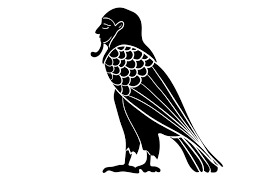
So what happened? Turns out the Late Dynastic Period ended in around 3100 BCE, or 5100 years ago, and the Old Kingdom lasted from around 2700-2200 BCE, or 4700-4200 years ago, which is a dumb long time ago. In that stretch of around 900 years, the saddle-billed stork went extinct in Egypt! The poor artists that were tasked with depicting the saddle-billed stork had never seen one before, so they decided to change the symbol. The legendary run of the saddle-billed stork hieroglyph, a run I think about every day, lasted three times longer than the existence of the United States, and ended over 2000 years before the birth of Jesus. Egypt was around for so long that our tiny brains cannot comprehend how long it existed.
https://www.jstor.org/stable/41812313?read-now=1&seq=11#page_scan_tab_contents
54 notes
·
View notes
Text
IT'S TIME YOU ALL HEARD ABOUT MY GIRL ARCANGELA TARABOTTI, SALTIEST NUN IN CHRISTENDOM

So, I first heard about Arcangela Tarabotti while I was doing the study for my novella THE CITY BEYOND THE GLASS, which is set in Renaissance Venice and inspired by a real historical practice: At one point during the sixteenth century, nearly sixty percent of all the noble women in Venice lived in convents. And the vast majority of them were there against their will.
For complex dynastic reasons (or basically…money and prestige), only one son and one daughter in each generation of Venetian noble families were permitted to marry during this period. The remaining sons resorted to the famous Venetian courtesans to find the companionship which was denied them in marriage, while the spare daughters were locked into convents. The system was unsustainably wasteful and had to be abandoned within a few generations, but by that time it was already too late - many of the old patrician families of Venice were already going extinct. (You can read more on this in Jutta Gisela Sperling’s book Convents and the Body Politic in Late Renaissance Venice).
While it lasted, the system had plenty of opponents. In 1619, Patriarch Giovanni Tiepolo said, "More than two thousand patrician women…live in this city locked up in convents as if in a public tomb. …They are noblewomen, raised and nurtured with the highest delicacy and respect so that if they were of the other sex, they would command and govern the world."
Even when they have suffered oppression, women throughout history have challenged the status quo, and the women of Venice were no different. Arcangela Tarabotti is the foremost example.
Arcangela was just 11 years old when her father sent her to the convent of Sant'Anna. He considered her to be unmarriageable because she had a physical disability, which she had in fact inherited from him. She would spend the rest of her life there, taking vows as a nun in 1623…a fact about which she was in a white-hot fury.
"Why, then, do you defy the works of the Most Just One by decreeing that many women should live all together, alike in dress, dwelling place, food, and conduct, when the Lord of Lords makes it a miracle of His infinite wisdom for all things He created to be different? Why do you want to bend to your whim contrasting wills created so by nature? It is nothing less than wanting to change and correct the deeds of a Creator who cannot err."
During her early years in the cloister, Arcangela gained a reputation for rebellion and outspokenness. At one stage, it took a direct command from the Patriarch himself to force her to cut her hair. Despite this, Arcangela was able to access a high standard of education at the convent and became a philosopher and writer, corresponding with an impressive network of the thinkers of her day. She wrote multiple works critiquing the misogyny entrenched in Venetian society - including a scorching expose titled Paternal Tyranny.
“Only hell itself bears a likeness to the suffering of these enforced slaves of Christ," Arcangela wrote concerning the Venetian women imprisoned in nunneries. "Over the gate of Hell, Dante says, are inscribed the words ‘Abandon every hope, who enter here.’ The same could be inscribed over the portals of convents.”
Contrary to the polemicists of her day, Arcangela maintained that women were fully equal to men and even argued that they should be able to become lawyers and judges. "Both male and female were born free, bearing with them, like a precious gift from God, the priceless bounty of free choice. If in God’s eyes woman is not less privileged than you with respect to her physical or spiritual qualities, why do you wish her to seem created with such great inequality, you enemies of the truth, proclaiming her to be subject to your impulsive, mad whims? In short, woman is deserving of less respect than you only when you have reduced her to this state by your scheming."
"When women are seen with pen in hand, they are met immediately with shrieks commanding a return to that life of pain which their writing had interrupted, a life devoted to the women's work of needle and distaff," she argued.
Tarabotti maintained that she did not condemn all men simply for being men: "Stricken by a guilty conscience, some men will say that I speak with excessive temerity about all men in general. They are greatly mistaken. If they behave justly, they will be protected from my attacks and those of others. I separate the just from the wicked (who are the subject of my discourse), since not all men are bad and not all women are good."
As a keen amateur historian, I’m accustomed to wincing when people assume that all women living before about 1920 were ignorant, oppressed, and unable to inherit or control property (as if world history was not long and diverse and filled with creative, bold, and influential women). For a limited time during the Renaissance, however, things really were incredibly bad for Venetian women. To find out more about Arcangela and her times, I highly recommend Letizia Panizza's translation of PATERNAL TYRANNY, published in 2004 by the University of Chicago Press!
#history#renaissance history#venice#venetian history#women's history#renaissance women#historical fiction#renaissance#17th century#1600s#medieval women#women in history#feminism
313 notes
·
View notes
Text

Lioness Game Piece
Egyptian, ca. 2850 BCE (Early Dynastic Period, late 1st-2nd dynasty)
Ivory was used, from predynastic times forward, to create luxurious practical objects such as combs, hair pins, amulets, spoons, and knife handles (Drenkhahn 1986). Around 3000-2900 BCE, a distinctive class of ivory objects--gaming pieces in the form of animals--emerged. These small statuettes represent recumbent lions (both male and female) and hounds. The broad collar and absence of a mane indicate that the subject of the piece illustrated here is a female lion; the rectangular pectoral on the figure's breast is the result of modern recarving, and the high polish was not original to the figure. Such a figurine was probably used in the game of "Mehen" ("coiled one"), played on a round board in the form of a coiled serpent with a trapeziodal projection. The game was popular until the end of the Old Kingdom.
44 notes
·
View notes
Photo
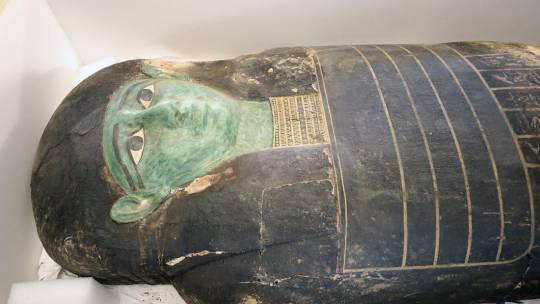



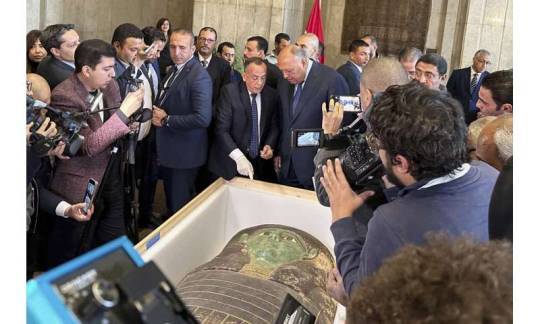
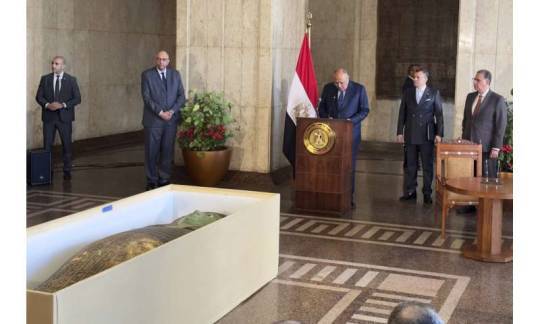
Looted Ancient Green Sarcophagus Returned to Egypt from US
An ancient wooden sarcophagus that was featured at the Houston Museum of Natural Sciences was returned to Egypt after U.S. authorities determined it was looted years ago, Egyptian officials said Monday.
The repatriation is part of Egyptian government efforts to stop the trafficking of its stolen antiquities. In 2021, authorities in Cairo succeeded in getting 5,300 stolen artifacts returned to Egypt from across the world.
Mostafa Waziri, the top official at the Supreme Council of Antiquities, said the sarcophagus dates back to the Late Dynastic Period of ancient Egypt, an era that spanned the last of the Pharaonic rulers from 664 B.C. until Alexander the Great's campaign in 332 B.C.
The sarcophagus, almost 3 meters (9.5 feet) tall with a brightly painted top surface, may have belonged to an ancient priest named Ankhenmaat, though some of the inscription on it has been erased, Waziri said.
It was symbolically handed over at a ceremony Monday in Cairo by Daniel Rubinstein, the U.S. chargé d'affaires in Egypt.
The handover came more than three months after the Manhattan District Attorney's Office determined the sarcophagus was looted from Abu Sir Necropolis, north of Cairo. It was smuggled through Germany into the United States in 2008, according to Manhattan District Attorney Alvin L. Bragg.
"This stunning coffin was trafficked by a well-organized network that has looted countless antiquities from the region," Bragg said at the time. "We are pleased that this object will be returned to Egypt, where it rightfully belongs."
Bragg said the same network had smuggled a gilded coffin out of Egypt that was featured at New York's Metropolitan Museum. Met bought the piece from a Paris art dealer in 2017 for about $4 million. It was returned to Egypt in 2019.
#Looted Ancient Sarcophagus Returned to Egypt from US#stolen antiquities#stolen artifacts#Abu Sir Necropolis#Late Dynastic Period#ancient artifacts#archeology#archeolgst#history#history news#ancient history#ancient culture#ancient civilizations#ancient egypt#egyptian history
61 notes
·
View notes
Note
If Tywin was to decide, a few years after Joanna's death, to remarry, who and what (in terms of marriage power) do you think he would go for?
The problem is, I can’t work in a scenario which by the author’s own admission would never happen. Tywin did not want to remarry, point blank, despite having plenty of opportunity (certainly in terms of time) to do so. Joanna was, I think, completely irreplaceable in Tywin’s mind as the ideal bride: the kinswoman whose main-line (male) Lannister pedigree identified her as elite among the levels of humanity (by Tywin’s calculus, anyway); the companion of his childhood at Casterly Rock, whom he had loved and had married at least in part for love; the trusted confidante who could not only make him smile and laugh but who had supposedly ruled Tywin personally as much as he had ruled as Hand politically; the mother of his golden twins, especially precious heir Jaime, the products of Tywin’s quest for politico-dynastic domination through Lannister perfection. Tywin, the man who never did anything by half measures - as small-scale as shaving his head when his hair began thinning or as large-scale as drowning every Reyne inside Castamere at the tail end of the Reyne-Tarbeck Rebellion - could not simply remarry after a proper period of mourning: he would remain a widower, publicly advertising his permanent status as only husband to the late Jonna.
If this all sounds mighty hypocritical given Tywin’s ruthless insistence on unhappy but diplomatically advantageous marriages for his children, as well as his violent and cruel outrage toward Tyrion and Tysha’s marriage purely for love … well, you’re right! Tywin was not, as much as he might have wanted to appear, a gilded android guided only by (what he saw as) cold logic and political acumen, but a deeply emotional man, driven by (among other things) love, anger, grief, hatred, pride, and jealousy. Tywin, but not his children, could sacrifice any potential political benefits to be had via aristocratic marriage/remarriage because he had felt Joanna’s death so strongly, because he wanted to honor her memory by not remarrying, because he needed to show how much he had loved her. (Which did not, of course, prevent Tywin from using sex workers before and after Joanna died - a reflection, I think, both of the hypocrisy in Tywin’s public perception versus his private life as well as Tywin’s attitude toward sex work specifically and people he considered subhuman more generally.)
Also, and it me so of course I have to say it, Tywin’s refusal to remarry after a beloved wife’s death is a nod to Philip IV in The Accursed Kings. In yet another parallel between Philip IV and Tywin, Druon’s Iron King was married only to Jeanne of Navarre (note the almost identical names of their respective wives), with Druon describing Jeanne as “the only love of [Philip’s] life” and noting that following Jeanne’s death Philip had “never wanted any other woman” and “had looked at none other and would never do so” (nearly identical to what Cersei, incorrectly, thinks about Tywin in the wake of his death).
89 notes
·
View notes
Text
Diners first making the acquaintance of this modern Arlene high-table delicacy generally become too busy enjoying it to bother inquiring about its origins. But its refined appearance as served by the royal kitchens in Prydon to the King's guests (or to casual passers-by, since Kynall Castle's refectories are open to all) goes far to conceal its robust genesis as a fishermen's dish of the coastal and riverine country between the eastern and western branches of the Upper Arlid.
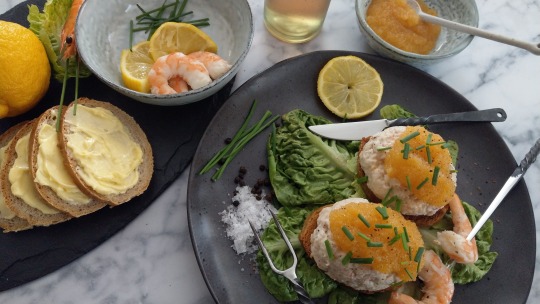
The original version of what would later be known as "Silver and Gold" (Arl./N.Arl. Dekhen-u-Ihrsen) was devised by North Arlene prawn fishermen who needed to find a use for shellfish they'd caught that were too small or damaged to offer in the coastal markets of Fûrdéin and Asfahæg. These "subpar" shrimp would be boiled in brine abroad ship and then kept submerged in frequently-renewed seawater until the fishermen made port.
There the ocean shrimp-fishers would meet with their freshwater-fishing counterparts, some of whom would be bringing in new-landed starscale pike (and other types) from the broad and busy breeding grounds of the upper Arlid delta. Cooked salt-water prawns would readily enough be bartered for sweetwater pike and their fine-grained, golden roe—or acquired by taverners in the "borderer" port towns east and west of Rûl Tyn—and cooked together with them.
A popular longshoremen's approach, because it kept well after cooking, was to mix and bind the chopped-up shrimps with grated dried bread and egg to make fish balls or thick cakes. These would be stuffed with chunks of roe from either marine or riverine fish—pike's roe being a favorite for its buttery and slightly smoky flavor, and the roes sometimes being cooked separately first. Then the (sometimes) breaded fishcakes would be fried in whatever fat was regionally most plentiful.1 The fried cakes could afterward be served up in a number of ways: by themselves—though often dipped in savory sauces heavy on whitefruit—pressed onto bread trenchers or sippets and sauced on top, or wrapped in wheaten or oaten platebreads in the Darthene coastal style.
But later on, during the period in the mid-1900s p.A.d.2 when a series of dynastic and climatic disasters led the North Arlene crown to resign most of its major functions to the Arlene Throne, the nature of the dish (as of many others originally native to North Arlen) began to change. Late-century cooks in Prydon and other northern Arlene cities began to upscale North Arlene cuisine in general as a kind of culinary tribute to a kingdom in decline. In the process they transformed this coastline shellfish dish into a more sophisticated composition seen (correctly or incorrectly) as more suited to urban palates, and tailored to emphasize the fresh marine flavor of the prawns.
The dish's modern name refers specifically to the classic Prydon-devised version in which the pale color of the meat of the shrimp is made to contrast strongly with the gold of pike caviar—in this presentation, now delicately rubbed out of the original "skeins" of roe to be served on top. And while we can certainly approach the flavor of the dish when making it on our own Earth, one thing we can't approach is the perfect paleness of the Arlene versions.
This is because we lack a specific and vital ingredient: the Arlene pewter shrimp, Metacrangon peltrumis medioregnis. While otherwise generally similar to Crangon crangon, the common our-Earth north Atlantic "gray shrimp", M. peltrumis is missing something normally commonplace among crustaceans: the protein complex called astaxanthin, which normally reacts with another complex called crustacyanin to produce the red shell and pinkish flesh coloration typical of cooked shrimps.3 As a result, the cooked flesh of the pewter shrimp is pure white, with no other colors to interfere with the shrimp's silvery presentation on the plate.
These more citified versions of dekhen-u-ihrsen involve, somewhat paradoxically, less cooking but more labor. After peeling and deveining, the cooked and chopped pewter shrimp are crushed and pounded in a mortar... hence the term "brayed" in the recipe name. (This indicates that the mortared shrimp mixture has a consistency smoother than something knife-chopped, but nonetheless more textured than an otherwise-mechanically produced puree.) After the addition of soured cream and spices, the mixture is molded between spoons and chilled in an ice-room until it firms slightly, and then served forth on toasted sippets and topped with iced pike caviar.
The use of the term "sallet" in the recipe name harks back (in one linguistic direction) to our many uses for the word "salad", and (in a different, more archaic one) to transitional early-1900s versions of the dish in which the pounded and formed shrimp was served out on roasted lettuce or cooked bitterleaf greens. In current versions, such as the one we illustrate here, greens are often still part of the presentation. But the main theme of the dish remains the contrast between the pale delicacy of the pounded shrimp and the glistening gold of the caviar.
See the right-hand tab on this page for the full recipe.
1 In North Arlen this would normally be sunflower, palm oil, or treenut oil (from the Middle Kingdoms version of our Shea tree, Vitellaria paradoxa).
2 The commonly-used abbreviation for pai Ajnedäre derüwin: "since the Arrival". i.e. of the Dragons, and the destruction of the Dark.
3 More information on our Earth's recent discovery of this chemical interaction can be found in this interesting paper.
87 notes
·
View notes
Text

The Gebelein Man “Ginger”
Found in Gebelein (Naga el-Gherira, South of Thebes)
Late Pre-Dynastic Period, c. 3400 B.C.
Now in the British Museum. EA32751
During the period of Gebelein Man’s life and death, Egyptians were buried in oval pit graves in a foetal position. Unlike their later descendants from the Dynastic age, they did not go through a ‘man-made’ mummification process; within these oval pit graves, bodies would become naturally mummified by the desert sands and climate.
It is thought these early burials were studied by later Egyptians to perfect the art (and science) of mummification, a technique the Dynastic Egyptians would of course become famous for.
The British Museum sent the body of the Gebelein Man to the Bupa Cromwell Hospital in London for C.T. scans in order to discover more about who he was and what may have actually happened to him. The discoveries were fascinating.
Read more
26 notes
·
View notes
Note
You know how in lots of modern art Egyptian men are portrayed shirtless a lot? I know it’s in some pictures on carved reliefs and stuff, but was it common for men to not wear a shirt or cover their torso, or was it a certain occasion sort of thing? Also do you know what sorts of looms were used in the Middle Kingdom, and what the most common fiber types were for everyday clothes? I assume linen was a big one but what about outer layers?
Yes, it was fairly common. It's a hot country and linen (depending on quality) is expensive and takes time to make. A loincloth or kilt is pretty typical male dress in Ancient Egypt, but a bag dress with a sash at the waist is also an option. The bag dress seems to have come more into fashion during the middle to late New Kingdom, but the Deir el Medina tombs (part of the Theban Tombs set or TT) of Amenemhat (TT340) and Inerkhau (TT359 & 299) both have depictions of this sort of dress.
The type of loom the Egyptians used didn't really change much throughout Pharaonic history. They use a horizontal ground loom that creates a tubular warp. Only in the New Kingdom did they get a vertical loom.
I'll link UCL's page on textiles here as it as a section on looms:
I'll also link Swansea Egypt Centre's blog post on them:
The most common fibre for clothes was linen. They could also use things like hemp, palm, and in the Pre Dynastic period analysis of the fabrics show they were also making them from grass and reeds. Woolen items have also been found, and these tend to mainly be shawls or cloaks for when it was cooler. The only thing they don't make clothes from is cotton. No cotton in Ancient Egypt.
If you want to know more about Egyptian clothing then I suggest reading this book by Gillian Vogelsang Eastwood (courtesy of @rudjedet):
121 notes
·
View notes